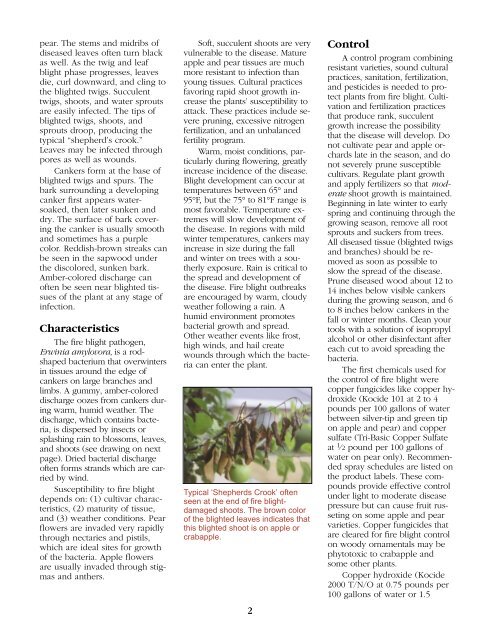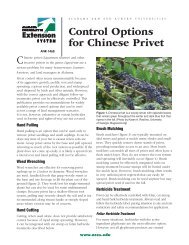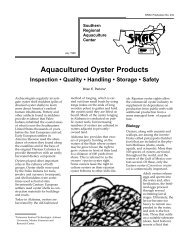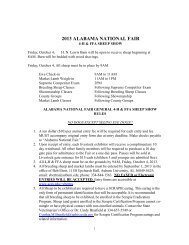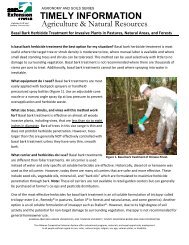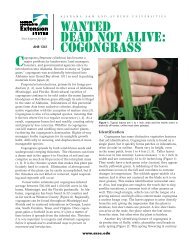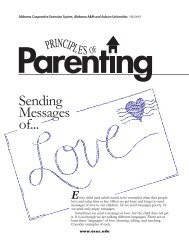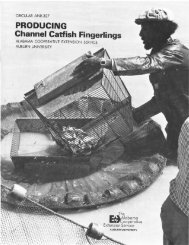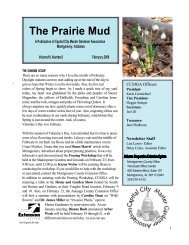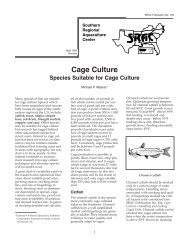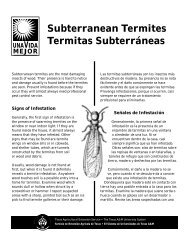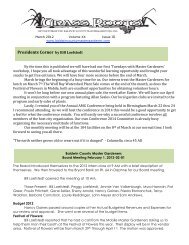Fire Blight on Fruit Trees and Woody Ornamentals - Alabama ...
Fire Blight on Fruit Trees and Woody Ornamentals - Alabama ...
Fire Blight on Fruit Trees and Woody Ornamentals - Alabama ...
You also want an ePaper? Increase the reach of your titles
YUMPU automatically turns print PDFs into web optimized ePapers that Google loves.
pear. The stems <strong>and</strong> midribs of<br />
diseased leaves often turn black<br />
as well. As the twig <strong>and</strong> leaf<br />
blight phase progresses, leaves<br />
die, curl downward, <strong>and</strong> cling to<br />
the blighted twigs. Succulent<br />
twigs, shoots, <strong>and</strong> water sprouts<br />
are easily infected. The tips of<br />
blighted twigs, shoots, <strong>and</strong><br />
sprouts droop, producing the<br />
typical “shepherd’s crook.”<br />
Leaves may be infected through<br />
pores as well as wounds.<br />
Cankers form at the base of<br />
blighted twigs <strong>and</strong> spurs. The<br />
bark surrounding a developing<br />
canker first appears watersoaked,<br />
then later sunken <strong>and</strong><br />
dry. The surface of bark covering<br />
the canker is usually smooth<br />
<strong>and</strong> sometimes has a purple<br />
color. Reddish-brown streaks can<br />
be seen in the sapwood under<br />
the discolored, sunken bark.<br />
Amber-colored discharge can<br />
often be seen near blighted tissues<br />
of the plant at any stage of<br />
infecti<strong>on</strong>.<br />
Characteristics<br />
The fire blight pathogen,<br />
Erwinia amylovora, is a rodshaped<br />
bacterium that overwinters<br />
in tissues around the edge of<br />
cankers <strong>on</strong> large branches <strong>and</strong><br />
limbs. A gummy, amber-colored<br />
discharge oozes from cankers during<br />
warm, humid weather. The<br />
discharge, which c<strong>on</strong>tains bacteria,<br />
is dispersed by insects or<br />
splashing rain to blossoms, leaves,<br />
<strong>and</strong> shoots (see drawing <strong>on</strong> next<br />
page). Dried bacterial discharge<br />
often forms str<strong>and</strong>s which are carried<br />
by wind.<br />
Susceptibility to fire blight<br />
depends <strong>on</strong>: (1) cultivar characteristics,<br />
(2) maturity of tissue,<br />
<strong>and</strong> (3) weather c<strong>on</strong>diti<strong>on</strong>s. Pear<br />
flowers are invaded very rapidly<br />
through nectaries <strong>and</strong> pistils,<br />
which are ideal sites for growth<br />
of the bacteria. Apple flowers<br />
are usually invaded through stigmas<br />
<strong>and</strong> anthers.<br />
Soft, succulent shoots are very<br />
vulnerable to the disease. Mature<br />
apple <strong>and</strong> pear tissues are much<br />
more resistant to infecti<strong>on</strong> than<br />
young tissues. Cultural practices<br />
favoring rapid shoot growth increase<br />
the plants’ susceptibility to<br />
attack. These practices include severe<br />
pruning, excessive nitrogen<br />
fertilizati<strong>on</strong>, <strong>and</strong> an unbalanced<br />
fertility program.<br />
Warm, moist c<strong>on</strong>diti<strong>on</strong>s, particularly<br />
during flowering, greatly<br />
increase incidence of the disease.<br />
<str<strong>on</strong>g>Blight</str<strong>on</strong>g> development can occur at<br />
temperatures between 65° <strong>and</strong><br />
95°F, but the 75° to 81°F range is<br />
most favorable. Temperature extremes<br />
will slow development of<br />
the disease. In regi<strong>on</strong>s with mild<br />
winter temperatures, cankers may<br />
increase in size during the fall<br />
<strong>and</strong> winter <strong>on</strong> trees with a southerly<br />
exposure. Rain is critical to<br />
the spread <strong>and</strong> development of<br />
the disease. <str<strong>on</strong>g>Fire</str<strong>on</strong>g> blight outbreaks<br />
are encouraged by warm, cloudy<br />
weather following a rain. A<br />
humid envir<strong>on</strong>ment promotes<br />
bacterial growth <strong>and</strong> spread.<br />
Other weather events like frost,<br />
high winds, <strong>and</strong> hail create<br />
wounds through which the bacteria<br />
can enter the plant.<br />
Typical ‘Shepherds Crook’ often<br />
seen at the end of fire blightdamaged<br />
shoots. The brown color<br />
of the blighted leaves indicates that<br />
this blighted shoot is <strong>on</strong> apple or<br />
crabapple.<br />
2<br />
C<strong>on</strong>trol<br />
A c<strong>on</strong>trol program combining<br />
resistant varieties, sound cultural<br />
practices, sanitati<strong>on</strong>, fertilizati<strong>on</strong>,<br />
<strong>and</strong> pesticides is needed to protect<br />
plants from fire blight. Cultivati<strong>on</strong><br />
<strong>and</strong> fertilizati<strong>on</strong> practices<br />
that produce rank, succulent<br />
growth increase the possibility<br />
that the disease will develop. Do<br />
not cultivate pear <strong>and</strong> apple orchards<br />
late in the seas<strong>on</strong>, <strong>and</strong> do<br />
not severely prune susceptible<br />
cultivars. Regulate plant growth<br />
<strong>and</strong> apply fertilizers so that moderate<br />
shoot growth is maintained.<br />
Beginning in late winter to early<br />
spring <strong>and</strong> c<strong>on</strong>tinuing through the<br />
growing seas<strong>on</strong>, remove all root<br />
sprouts <strong>and</strong> suckers from trees.<br />
All diseased tissue (blighted twigs<br />
<strong>and</strong> branches) should be removed<br />
as so<strong>on</strong> as possible to<br />
slow the spread of the disease.<br />
Prune diseased wood about 12 to<br />
14 inches below visible cankers<br />
during the growing seas<strong>on</strong>, <strong>and</strong> 6<br />
to 8 inches below cankers in the<br />
fall or winter m<strong>on</strong>ths. Clean your<br />
tools with a soluti<strong>on</strong> of isopropyl<br />
alcohol or other disinfectant after<br />
each cut to avoid spreading the<br />
bacteria.<br />
The first chemicals used for<br />
the c<strong>on</strong>trol of fire blight were<br />
copper fungicides like copper hydroxide<br />
(Kocide 101 at 2 to 4<br />
pounds per 100 gall<strong>on</strong>s of water<br />
between silver-tip <strong>and</strong> green tip<br />
<strong>on</strong> apple <strong>and</strong> pear) <strong>and</strong> copper<br />
sulfate (Tri-Basic Copper Sulfate<br />
at 1 ⁄2 pound per 100 gall<strong>on</strong>s of<br />
water <strong>on</strong> pear <strong>on</strong>ly). Recommended<br />
spray schedules are listed <strong>on</strong><br />
the product labels. These compounds<br />
provide effective c<strong>on</strong>trol<br />
under light to moderate disease<br />
pressure but can cause fruit russeting<br />
<strong>on</strong> some apple <strong>and</strong> pear<br />
varieties. Copper fungicides that<br />
are cleared for fire blight c<strong>on</strong>trol<br />
<strong>on</strong> woody ornamentals may be<br />
phytotoxic to crabapple <strong>and</strong><br />
some other plants.<br />
Copper hydroxide (Kocide<br />
2000 T/N/O at 0.75 pounds per<br />
100 gall<strong>on</strong>s of water or 1.5


